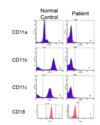2.5.2 Diseases of Leukocyte Adhesion Flashcards
What is the role of CD18?
Adhesion of leukocytes to endothelial cells
What is another term of CD21?
CR2
What is another term of CD95?
Fas
Answer

C
What cell type represents the greatest fraction of the white blood cell count?
Neutrophils
What is the role of G-CSF?
Stimulation of neutrophil production
What type of bacteria induce a strong neutrophil response?
Pyogenic bacteria
The neutrophil ligand CD15s (sialyl-Lewis) binds to what on endothelial cells?
CD62E (e-selectin) and CD62P (P-selectin)
GlyCAM-1 and CD34 on the endothelium bind to what on the neutrophil?
CD-62L (L-selectin)
What carries out the integrin-mediated tight adhesion?
CD11a/CD18 (LFA-1) and CD11b/CD18 (Mac-1, CR3) bind to CD54 (ICAM-1) and CD102 (ICAM-2) on the endothelium
What carries out the process of diapedesis for neutrophils?
CD31 (PECAM-1) expressed by the emigrating neutrophil interacts with CD31 expressed at the endothelial cell-cell junction.
What are some chemoattractants for neutrophils?
C5a, leukotrienes, and IL-8
How can an infection change the distribution of neutrophils in the body?
Infection will cause neutrophils to be more in the tissue.
How can epinephrine change the distribution of neutrophils in the body?
It can increase the circulating pool of neutrophils
Steroids will have what effect on the distribution of neutrophils?
It will increase the circulating pool of neutrophils. Leading to slight depression of neutrophils in the bone marrow.
What is the cause of neutropenia resulting from peripherial pooling?
Acute endotoxemia
What are some causes of decreased production of neutrophils resulting in neutropenia?
Drug induced, aplastic anemia, folate deficiency, and Chediak-Higashi syndrome
What are some common causes of neutrophilia?
Glucocorticoids, infection, inflammation, epinephrine, and stress
What is chronic granulomatous disease?
Loss of a subunit of NADPH oxidase leading to decreased phagocyte function of neutrophils
What is Chediak-Higashi Syndrome?
Reduced phagolysosome fusion
Defective egress from marrow
What is the underlying cause of LAD - Type 1?
CD18 deficiency
What is the underlying cause of LAD - Type 2?
Reduced expression of Sialyl-Lewis
Test result of phagocytosis of fresh serum-opsonized staph is very low, what can this indicate?
There is a problem with complement-mediated phagocytosis
What are these flow cytometry results indicative of?

Patient does not have any CD11 or CD18 protein.
After review of these flow cytometry results what is a probable diagnosis?

LAD - Type 1 resulting from a CD18 deficiency. Neutrophils cannot adhere to the endothelium.
Patient presents to clinic with numerous cotton-ball densities, and upon fine needle aspiration Apergillus fumigatus is cultured. Testing for reduction of dihydrorhodamine following C5a is impaired. What can be a possible cause?
There is a problem with the oxidative burst pathway. Particularily in NADPH oxidase. Chronic granulomatous disease.
Would a patient with myeloperoxidase deficiency present in the same way a patient with chronic granulomatous disease would?
No, myeloperoxidase is downstream in the oxidative burst, so most bacteria can be taken out by the first two steps of the pathway. These patients can appear asymptomatic.


